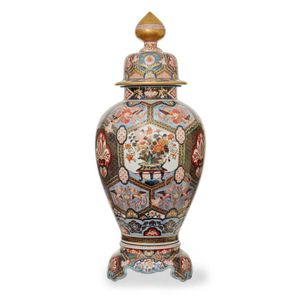Japanese Enamel Floor Vase with Shishi and Peony Design
You must be a subscriber, and be logged in to view price and dealer details.
Subscribe Now to view actual auction price for this item
When you subscribe, you have the option of setting the currency in which to display prices to $Au, $US, $NZ or Stg.
- Cartouche - An ornamental panel in the form of of a shield, oval or rectangular scroll with curling edges. It may be carved into the back of a chair or the top of a sideboard, or present on a piece of silver or jewellery, and contain the initials of the original owner, heraldic symbols, or some other inscription, such as the details of a presentation.
In ceramics the term defines the central area of a vase or similar with a decorative border in one of the shapes above, into which a decorative scene or figures have been painted. - Finial - An architectural decoration, found on the upper parts of of an object. On furniture they are usually found on pediments, canopies and shelf supports. On smaller ceramic or silver items, such as spoons, they may decorate the top of the item itself, or the lid or cover where they provide a useful handle for removal.
Finials have a variety of shapes and forms. They may be urn-shaped, baluster shaped round or spiral, but usually taper into an upper point. Many real life shapes may also be used as finials, such as pineapples, berries, pinecones, buds, lotus and acorns. Sometimes animals such as a lion are depicted, or fish and dolphins. - Overglaze on Porcelain - Overglaze decoration on porcelain refers to a decorative technique where designs are painted onto a fired and glazed porcelain surface, and then fired again at a lower temperature to fuse the decorative design onto the glaze surface. This technique allows for a wide range of colors and intricate designs that would not be possible with underglaze decoration, which is applied before the glaze is fired.
This item has been included into following indexes:
Visually similar items

An impressive Japanese gilt and enamel floor vase signed Arita-Yaki, 20th century, of baluster shape, the central cartouche theme of Botan-shishi or peony and Shishi (Foo dog), a traditional decorative theme in Japanese Art seen as symbolic of nobility and

A Japanese Imari covered vase, gilt and polychrome Enamels, 19th/20th century, large and impressive Imari covered vase of baluster form with very fine polychrome enamel work, with background of tortoise shell and traditional wave design, the main cartouche

A Japanese Imari covered vase, gilt and polychrome Enamels 19th/20th century, large and impressive Imari covered vase of baluster form with very fine polychrome enamel work, with background of tortoise shell and traditional wave design, the main cartouche

A large Royal Worcester pot pourri vase and two covers, 1889, of melon form, the pierced cover and liner above moulded gilded shoulder, painted with flowers picked in gilt, 33.5 cm high
